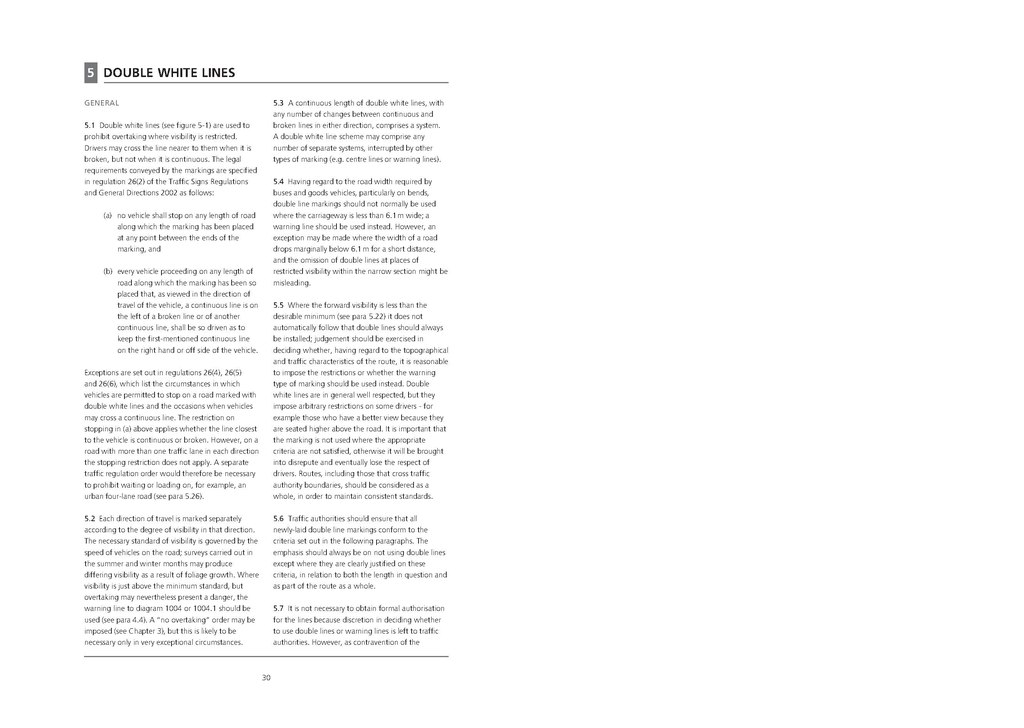5DOUBLE WHITE LINES
GENERAL
5.1 Double white lines (see figure 5-1) are used to prohibit overtaking where visibility is restricted. Drivers may cross the line nearer to them when it is broken, but not when it is continuous. The legal requirements conveyed by the markings are specified in regulation 26(2) of the Traffic Signs Regulations and General Directions 2002 as follows:
(a)no vehicle shall stop on any length of road along which the marking has been placed at any point between the ends of the marking and
(b)every vehicle proceeding on any length of road along which the marking has been so placed that, as viewed in the direction of travel of the vehicle, a continuous line is on the left of a broken line or of another continuous line, shall be so driven as to keep the first-mentioned continuous line on the right hand or off side of the vehicle.
Exceptions are set out in regulations 26(4), 26(5) and 26(6), which list the circumstances in which vehicles are permitted to stop on a road marked with double white lines and the occasions when vehicles may cross a continuous line. The restriction on stopping in (a) above applies whether the line closest to the vehicle is continuous or broken. However, on a road with more than one traffic lane in each direction the stopping restriction does not apply. A separate traffic regulation order would therefore be necessary to prohibit waiting or loading on, for example, an urban four-lane road (see para 5.26).
5.2 Each direction of travel is marked separately according to the degree of visibility in that direction. The necessary standard of visibility is governed by the speed of vehicles on the road; surveys carried out in the summer and winter months may produce differing visibility as a result of foliage growth. Where visibility is just above the minimum standard, but overtaking may nevertheless present a danger, the warning line to diagram 1004 or 1004.1 should be used (see para 4.4). A "no overtaking" order may be imposed (see Chapter 3), but this is likely to be necessary only in very exceptional circumstances.
5.3 A continuous length of double white lines, with any number of changes between continuous and broken lines in either direction, comprises a system. A double white line scheme may comprise any number of separate systems, interrupted by other types of marking (e.g. centre lines or warning lines).
5.4 Having regard to the road width required by buses and goods vehicles, particularly on bends, double line markings should not normally be used where the carriageway is less than 6.1 m wide; a warning line should be used instead. However, an exception may be made where the width of a road drops marginally below 6.1 m for a short distance, and the omission of double lines at places of restricted visibility within the narrow section might be misleading.
5.5 Where the forward visibility is less than the desirable minimum (see para [#5.22|5.22]]) it does not automatically follow that double lines should always be installed; judgement should be exercised in deciding whether, having regard to the topographical and traffic characteristics of the route, it is reasonable to impose the restrictions or whether the warning type of marking should be used instead. Double white lines are in general well respected, but they impose arbitrary restrictions on some drivers - for example those who have a better view because they are seated higher above the road. It is important that the marking is not used where the appropriate criteria are not satisfied, otherwise it will be brought into disrepute and eventually lose the respect of drivers. Routes, including those that cross traffic authority boundaries, should be considered as a whole, in order to maintain consistent standards.
5.6 Traffic authorities should ensure that all newly-laid double line markings conform to the criteria set out in the following paragraphs. The emphasis should always be on not using double lines except where they are clearly justified on these criteria, in relation to both the length in question and as part of the route as a whole.
5.7 It is not necessary to obtain formal authorisation for the lines because discretion in deciding whether to use double lines or warning lines is left to traffic authorities. However, as contravention of the
30
